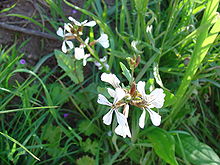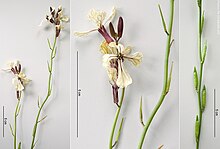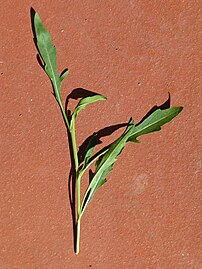Eruca vesicaria
| Eruca vesicaria | |
|---|---|

| |
| Scientific classification | |
| Kingdom: | Plantae |
| Clade: | Tracheophytes |
| Clade: | Angiosperms |
| Clade: | Eudicots |
| Clade: | Rosids |
| Order: | Brassicales |
| Family: | Brassicaceae |
| Genus: | Eruca |
| Species: | E. vesicaria
|
| Binomial name | |
| Eruca vesicaria | |
| Synonyms | |
|
Arugula | |
Rocket,eruca,[1]orarugula(Eruca vesicaria;syns.Eruca sativaMill.,E. vesicariasubsp.sativa(Miller) Thell.,Brassica erucaL.) is an edibleannual plantin the familyBrassicaceaeused as aleaf vegetablefor its fresh, tart, bitter, and peppery flavor. Its other common names includegarden rocket[2](in Great Britain, Australia, South Africa, Ireland, and New Zealand),[1]as well ascolewort,roquette,ruchetta,rucola,rucoli,andrugula.
Native to theMediterranean region,E. vesicariais widely popular as asalad vegetable.[3][1][4]
Description
[edit]Eruca vesicariais anannual plant[5]growing to 20 to 100 cm (8 to 40 in) in height. Thepinnateleaves are deeply lobed with four to ten, small, lateral lobes and a large terminal lobe. Theflowersare2 to 4 cm (3⁄4to1+1⁄2in) in diameter, arranged in acorymb,with the typical Brassicaceae flower structure. The petals are creamy white with purple veins, and the stamens are yellow. The fruit is asiliqua(pod)12 to 25 mm (1⁄2to 1 in) long with an apical beak, containing several seeds. The species has achromosome numberof 2n = 22.[1][2][6]
Names
[edit]Sativa,from one of the plant'ssynonyms,is fromsatum,meaning "to sow", indicating that the seeds of the plant were sown in gardens.Eruca sativadiffers fromE. vesicariain having earlydeciduoussepals.[2]Some botanists consider it asubspeciesofE. vesicariaasE. v.subsp.sativa.[2]Still others do not differentiate between the two.[7]
The English common namerocketderives from Frenchroquette,itself a borrowing from Italianruchetta,a diminutive ofruca,from the Latin worderuca.[8]
"Arugula" (/əˈruːɡələ/), the common name now widespread in the United States and Canada, entered American English from a nonstandard dialect of Italian. The standard Italian word is "rucola". TheOxford English Dictionarydates the first known appearance of "arugula" in American English to a 1960 article inThe New York Timesby food editor and prolific cookbook writer,Craig Claiborne.[9]
Synonyms
[edit]
According tothe Plant List,the following are synonyms:[10]
- Brassica erucaL.
- Brassica erucoidesHornem.
- Brassica erucoidesRoxb.
- Brassica lativalvisBoiss.
- Brassica pinnatifidaDesf.
- Brassica turgidaPers.
- Brassica uechtritzianaJanka
- Brassica vesicariaL.
- Crucifera erucaE. H. L. Krause
- Eruca aureaBatt.
- Eruca cappadocicaReut.
- Eruca cappadocicaReut. ex Boiss.
- Eruca desertiPomel
- Eruca drepanensisCaruel
- Eruca eruca(L.) Asch. & Graebn.nom. inval.
- Eruca foetidaMoench
- Eruca glabrescensJord.
- Eruca grandifloraCav.
- Eruca lanceolataPomel
- Eruca latirostrisBoiss.
- Eruca longirostrisUechtr.
- Eruca longistylaPomel
- Eruca oleraceaJ.St.-Hil.
- Eruca orthosepala(Lange) Lange
- Eruca permixtaJord.
- Eruca pinnatifida(Desf.) Pomel
- Eruca ruchettaSpach
- Eruca sativaMill.
- Eruca stenocarpaBoiss. & Reut.
- Eruca sylvestrisBubani
- Euzomum hispidumLink
- Euzomum sativumLink
- Euzomum vesicarium(L.) Link
- Raphanus eruca(L.) Crantz
- Raphanus vesicarius(L.) Crantz
- Sinapis eruca(L.) Clairv.
- Sinapis eruca(L.) Vest
- Velleruca longistylaPomel
- Velleruca vesicaria(L.) Pomel
Similarly named plants
[edit]Rocket is sometimes conflated withDiplotaxis tenuifolia,known as 'perennial wall rocket', another plant of the family Brassicaceae that is used in the same manner.
Species ofBarbareamay be known as 'yellow rocket'.
Brassica oleraceamay also be known by the common name 'colewort'.
Ecology
[edit]E. vesicariais native to southern Europe, North Africa and the Middle East. As an invasive species arugula is widespread but scattered though is prolific and noxious in the Sonora desert of Arizona and California.[11]
The species typically grows on dry, disturbed ground. It is a source of food for thelarvaeof some moth species,[1][2]including thegarden carpet.Its roots are susceptible tonematodeinfestation.[12]
Cultivation
[edit]
Grown as an edible and popular herb in Italy sinceRomantimes, arugula was mentioned by various ancient Roman classical authors as anaphrodisiac,[13][14]most famously in a poem long ascribed to the famous first century Roman poetVirgil,Moretum,which contains the line: "et Venerem revocans eruca morantem"(" and the rocket, which revives drowsy Venus [sexual desire] "),[15]and in theArs AmatoriaofOvid.[16]Some writers assert that for this reason, during the Middle Ages, growing arugula was forbidden in monasteries.[17]Nonetheless, the plant was listed in adecreebyCharlemagneas among the 802 pot herbs suitable for growing in gardens.[18]Gillian Riley, author of theOxford Companion to Italian Food,states that because of its reputation as a sexual stimulant, it was "prudently mixed with lettuce, which was the opposite" (i.e., calming or even soporific). Riley continues, "nowadays rocket is enjoyed innocently in mixed salads, to which it adds a pleasing pungency",[19]althoughNorman Douglasinsisted, "Salad rocket is certainly a stimulant".[20]
The plant was traditionally collected in the wild or grown in home gardens along with herbs, such as parsley and basil. Arugula now is grown commercially in many places and is available in supermarkets and farmers markets worldwide. It now isnaturalizedas a wild plant away from its native range in temperate regions around the world, including northern Europe and North America.[21][1]In India, the mature seeds are known as "Gargeer". This is the same name used in Arabic,جِرْجِير(jirjīr), but used in Arab countries this name is used for the fresh leaves of the plant.
Mild frost conditions hinder the plant's growth and turn the green leaves to red.[22][23]If the weather is warm plants mature to full size in 40 to 50 days.[24]
| Nutritional value per 100 g (3.5 oz) | |||||||||||||||||||||||||||||||||||||||||||||||||||
|---|---|---|---|---|---|---|---|---|---|---|---|---|---|---|---|---|---|---|---|---|---|---|---|---|---|---|---|---|---|---|---|---|---|---|---|---|---|---|---|---|---|---|---|---|---|---|---|---|---|---|---|
| Energy | 105 kJ (25 kcal) | ||||||||||||||||||||||||||||||||||||||||||||||||||
3.6 g | |||||||||||||||||||||||||||||||||||||||||||||||||||
| Sugars | 2.0 g | ||||||||||||||||||||||||||||||||||||||||||||||||||
| Dietary fiber | 1.6 g | ||||||||||||||||||||||||||||||||||||||||||||||||||
0.6 g | |||||||||||||||||||||||||||||||||||||||||||||||||||
2.6 g | |||||||||||||||||||||||||||||||||||||||||||||||||||
| |||||||||||||||||||||||||||||||||||||||||||||||||||
| Other constituents | Quantity | ||||||||||||||||||||||||||||||||||||||||||||||||||
| Water | 91.7 g | ||||||||||||||||||||||||||||||||||||||||||||||||||
| †Percentages estimated usingUS recommendationsfor adults,[25]except for potassium, which is estimated based on expert recommendation fromthe National Academies.[26] | |||||||||||||||||||||||||||||||||||||||||||||||||||
Uses
[edit]Nutrition
[edit]Raw arugula is 92% water, 4% carbohydrates, 2.5% protein, and contains a negligible amount of fat. A100 g (3+1⁄2oz) reference serving provides only 105 kJ (25 kcal) offood energy.It is a rich source (20% or more of the Daily Value, DV) offolateandvitamin K.Arugula is also a good source (10–19% of DV) ofvitamin A,vitamin C,and the dietary mineralscalcium,magnesium,andmanganese.It also includespotassium.[27]
Arugula is generally notallergenic.
Culinary
[edit]The leaves, flowers, young seed pods, and mature seeds are all edible.
Since Roman times in Italy, raw arugula has been added to salads. It often is added as a garnish to a pizza at the end of or just after baking. InApulia,in southern Italy, arugula is cooked to make the pasta dish "cavatiéddi", "in which large amounts of coarsely chopped rocket are added to pasta seasoned with a homemade reduced tomato sauce andpecorino",[28]as well as in many recipes in which it is chopped and added to sauces and cooked dishes or in a sauce (made by frying it in olive oil with garlic). It also is used as a condiment for cold meats and fish.[28]Throughout Italy, it is used as a salad with tomatoes and withburrata,bocconcini,buffalo,or mozzarella cheese. In Rome, "rucola" is used in "straccetti", a dish of thin slices of beef with raw arugula and Parmesan cheese.[29]
In Turkey, similarly, the plant is eaten raw as a side dish or salad with fish or is served with a sauce of extra virgin olive oil and lemon juice.[30]
In Slovenia, arugula often is combined with boiled potatoes[31]or used in a soup.[32]
In West Asia, Pakistan, and northern India,Erucaseeds are pressed to maketaramira oil,used in pickling and (after aging to remove acridity) as a salad or cooking oil.[33]Theseed cakeis also used as animal feed.[34]
From about the 1990s[35]arugula has become more popular in America, especially in trendier restaurants and in urban areas.[36]
References
[edit]- ^abcdefBlamey, M. & Grey-Wilson, C. (1989).Flora of Britain and Northern Europe.ISBN0-340-40170-2.
- ^abcdeFlora of NW Europe:Eruca vesicariaArchived2007-10-14 at theWayback Machine
- ^Med-Checklist:Eruca sativa.
- ^Yaniv, Zohara; Schafferman, D.; Amar, Z. (1998)."Tradition, Uses and Biodiversity of Rocket (Eruca sativa, Brassicaceae) in Israel".Economic Botany.52(4): 394–400.doi:10.1007/BF02862069.JSTOR4256115.S2CID36181033.
- ^Kole, Chittaranjan (21 February 2011).Wild Crop Relatives: Genomic and Breeding Resources: Oilseeds.Springer Science & Business Media.ISBN978-3-642-14871-2.Retrieved25 September2023.
- ^Huxley, A., ed. (1992).New RHS Dictionary of Gardening.MacmillanISBN0-333-47494-5.
- ^"Flora Europaea Search Results".rbge.org.uk.
- ^Oxford English Dictionary
- ^Claiborne, Craig (May 24, 1960)."A Green by Any Name: Pungent Ingredient Is Cause of Confusion for City Shopper; Arugula – or Rocket – Is the Secret of Experts' Salads".The New York Times.p. 33.
- ^The Plant List: A Working List of All Plant Species,retrieved11 May2016
- ^"Eruca vesicaria (garden-rocket): Go Botany".gobotany.nativeplanttrust.org.Retrieved2023-09-18.
- ^"Arugula: Arugula".smartgardener.com.
- ^Upton, Julie, RD."7 Foods for Better Sex".Health.com.Archived fromthe originalon April 10, 2015.RetrievedJuly 5,2010.
{{cite web}}:CS1 maint: multiple names: authors list (link) - ^Wright, Clifford A. (2001).Mediterranean Vegetables.Harvard Common Press. p.27.ISBN9781558321960.
- ^Virgil, 102Moretum:85. Joseph J. Mooney in his 1916 English translation,"The Salad",calls it "colewort" and notes, "The Latin" moretum ", which is usually translated" salad ", would be better called" cheese and garlic paste ", i.e.,pesto.SeeThe Minor Poems of Vergil: Comprising the Culex, Dirae, Lydia, Moretum, Copa, Priapeia, and Catalepton(Birmingham: Cornish Brothers, 1916), scanned as part ofAppendix Vergiliana: The Minor Poems of Virgil in English Translationon the website Virgil.org.
- ^Ovid,The Love Poems(Oxford 2008) p. 119
- ^Padulosi, Pignone D., Editors,Rocket: A Mediterranean Crop for the World(International Plant Genetic Resources Institute,1997), p. 41.
- ^Helen Morgenthau Fox,Gardening With Herbs for Flavor and Fragrance(1933, reprinted New York: Dover, 1970), p. 45. See alsoDenise Le Dantec and Jean-Pierre Le Dantec,Reading the French Garden: Story and History(MIT Press, 1998), p. 14.
- ^Gillian Riley,The Oxford Companion to Italian Food(Oxford University Press, 2008), p. 446.
- ^Ovid,The Love Poems(Oxford 2008) p. 232
- ^USDA Plants Profile:Eruca vesicariasubsp.sativa
- ^"The Secret of the Local Red Arugula".Archived fromthe originalon February 2, 2014.RetrievedMay 24,2013.
- ^"Minnesota Spring".Archived fromthe originalon June 30, 2013.RetrievedMay 24,2013.
- ^"Eruca vesicaria (Arugula, Eruca, Garden Rocket, Gharghir, Mediterranean Salad, Rocket, Rocket Salad, Roquette, Ruchtetta, Rucola, Rucoli, Rugula, Rugulas, Salad Rocket)".North Carolina Extension Gardener Plant Toolbox.North Carolinia State University.Retrieved30 January2024.
- ^United States Food and Drug Administration(2024)."Daily Value on the Nutrition and Supplement Facts Labels".FDA.Archivedfrom the original on 2024-03-27.Retrieved2024-03-28.
- ^National Academies of Sciences, Engineering, and Medicine; Health and Medicine Division; Food and Nutrition Board; Committee to Review the Dietary Reference Intakes for Sodium and Potassium (2019). Oria, Maria; Harrison, Meghan; Stallings, Virginia A. (eds.).Dietary Reference Intakes for Sodium and Potassium.The National Academies Collection: Reports funded by National Institutes of Health. Washington, DC: National Academies Press (US).ISBN978-0-309-48834-1.PMID30844154.Archivedfrom the original on 2024-05-09.Retrieved2024-06-21.
- ^NutritionData.com,Arugula, Raw
- ^abReilly,The Oxford Companion to Italian Food,p. 446
- ^"Beef Strips with Rocket – Straccetti con la Rucola".thefoodellers.com.Retrieved2021-05-17.
- ^"Oktay Usta'dan Roka Salatası Resimli Tarifi".Archived fromthe originalon 2015-06-24.Retrieved2015-04-16.
- ^"Solata s krompirjem in rukolo".dnevnik.si.
- ^"Krompirjeva juha z rukolo".zurnal24.
- ^G.J.H. Grubben and O.A. Denton, ed. (2004)."Vegetables".Plant Resources of Tropical Africa.Vol. 2. PROTA. p. 295.ISBN90-5782-147-8.
- ^Das, Srinabas; Kumar Tyagi; Harjit Kaur (2004)."Evaluation of taramira oil-cake and reduction of its glucosinolate content by different treatments".Indian Journal of Animal Sciences.73(6): 687–691.
- ^"Arugula History and Facts".bwqualitygrowers.com.Retrieved2024-05-07.
- ^"Arugula".tastewise.io.Retrieved2023-09-18.
External links
[edit]- Jeane Osnos, "The most political vegetables: A whirlwind tour of the edible crucifers,"The Botanist in the Kitchen,November 20, 2012.How arugula joined broccoli (and lattes) as supposed markers for big-government liberalism.
- Joel Denker, "The 'Lascivious' Leaf: The Allure of Arugula,"Food in the 'Hood(published August 11, 2012)ArchivedSeptember 25, 2020, at theWayback Machine,inThe Intowner, Serving Washington, D. C. since 1968.
- Ezra Klein, "Arugula",The American Prospect,October 7, 2008.
- John Schwenkler, "Eating arugula has become a political act: Conservative thinker is branded a closet liberal based on the food he eats,"Earth Matters,MNN (Mother Nature Network), March 2009.Mr. Schwenkler's article originally appeared inPlentymagazine in October 2008.
- David Kamp,The United States of Arugula: How We Became a Gourmet Nation,New York: Clarkson Potter (2006).Archived2020-02-18 at theWayback Machine




